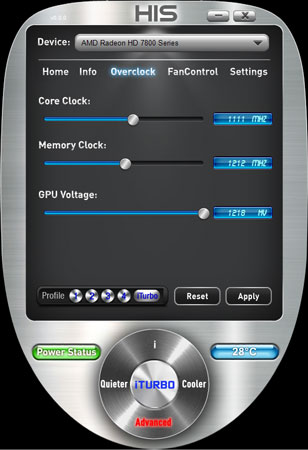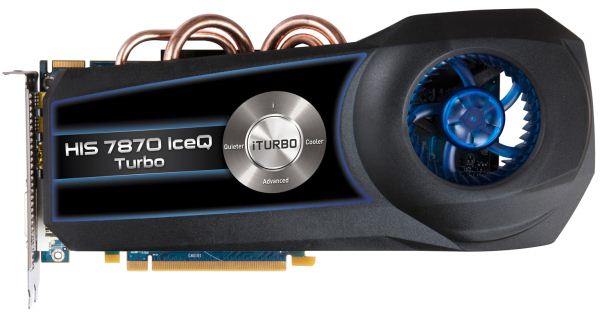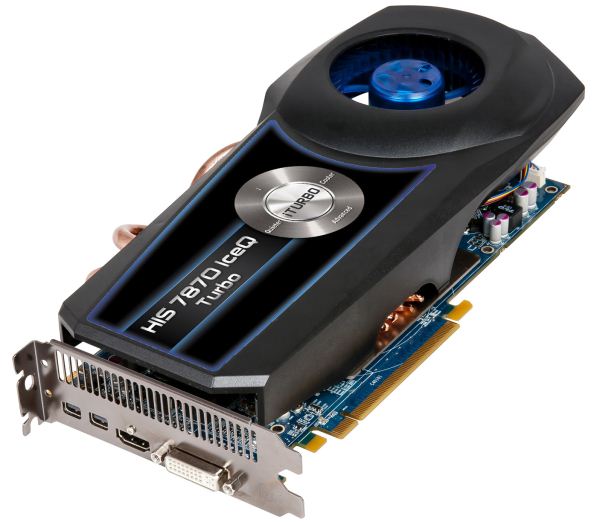The Retail Radeon HD 7870 Review: HIS 7870 IceQ Turbo & PowerColor PCS+ HD7870
by Ryan Smith on March 19, 2012 9:00 AM EST- Posted in
- GPUs
- AMD
- PowerColor
- Radeon HD 7000
- HIS
Two weeks ago AMD officially unveiled the Radeon HD 7800 series. Composed of the Radeon HD 7870 GHz Edition and Radeon HD 7850, AMD broke from their earlier protocol with the 7700 and 7900 series and unveiled the cards ahead of their actual launch in order to beat CeBIT and GDC. The result was a pair of impressive – if expensive – cards that cemented AMD’s control of the high-end video card market. Unfortunately because of this early unveiling you couldn’t buy one at the time.
Those two weeks have now come and gone, and the 7800 series has finally been released for sale. Because AMD’s partners have largely passed on AMD’s reference design for the 7870 series we wanted to take a look at what the actual retail cards would be like; with almost everyone using a custom cooler and many partners using factory overclocks, there’s a great deal of variation between cards. To that end HIS and PowerColor have sent over their top 7870 cards, the HIS 7870 IceQ Turbo and the PowerColor PCS+ HD7870. How do these retail cards stack up compared to our reference 7870, and what kind of impact do their factory overclocks bring? Let’s find out.
| AMD GPU Specification Comparison | |||||
| PowerColor PCS+ HD7870 | HIS IceQ Turbo 7870 | AMD Radeon HD 7870 (Ref) | |||
| Stream Processors | 1280 | 1280 | 1280 | ||
| Texture Units | 80 | 80 | 80 | ||
| ROPs | 32 | 32 | 32 | ||
| Core Clock | 1100MHz | 1100MHz | 1000MHz | ||
| Memory Clock | 4.9GHz GDDR5 | 4.8GHz GDDR5 | 4.8GHz GDDR5 | ||
| Memory Bus Width | 256-bit | 256-bit | 256-bit | ||
| Frame Buffer | 2GB | 2GB | 2GB | ||
| PowerTune Limit | 190W | 190W | 190W | ||
| Manufacturing Process | TSMC 28nm | TSMC 28nm | TSMC 28nm | ||
| Width | Double Slot | Triple Slot | Double Slot | ||
| Length | 9.5" | 11.25" | 9.5" | ||
| Warranty | 2 Years | 2 Years | N/A | ||
| Price Point | $370 | $390 | $350 | ||
PowerColor PCS+ HD7870
Starting first with the PowerColor card, we have the PCS+ HD7870. The PCS+ HD7870 is PowerColor’s high end 7870, and the only semi-custom card the company is making. As indicated by the PCS+ moniker, this 7870 is a factory overclocked card using a custom cooling solution. PowerColor has clocked the card at 1100MHz core and 4.9GHz memory, which is a 100MHz (10%) core overclock and a far less significant 100MHz (2%) memory overclock over the reference 7870. In large part due to the fact that AMD’s Pitcairn GPU overclocks so well on stock voltage, PowerColor isn’t doing any kind of voltage adjustment here, so the PCS+ operates at the same 1.219v as a reference 7870.
In terms of construction the PCS+ is a semi-custom card, meaning PowerColor is using their own cooler in conjunction with AMD’s PCB. PowerColor’s cooler of choice for the PCS+ HD7870 is a new design for the company, and is effectively a minor variation on the open air coolers we commonly see on sub-200W cards such as the 7870. For the PCS+ heat dissipation is provided by an aluminum heatsink that runs nearly the entire length of the card, which in turn is attached to the GPU through the use of an aluminum baseplate and 3 aluminum heatpipes that provide contact with the GPU.
Meanwhile airflow over the heatsink is provided by a 92mm fan near the center of the card, which is a bit bigger of a fan than the 80mm fans we typically see on open air coolers. The cooler itself is no larger than the card, which means the card’s length is the same as the 7870 PCB at 9.5”.

Looking elsewhere, along the top of the card we find a black metal stiffener, which in the absence of the reference 7870’s full shroud provides structural stability to the card. We still aren’t seeing stiffeners being used regularly enough on these kinds of open air cards, so we’re glad to see PowerColor is going about this the right way. Finally at the front of the card we can see that PowerColor is using the stacked DVI option that the AMD PCB provides, which brings the total number of ports to 5: 2 miniDP, 1 HDMI, 1 DL-DVI, and 1 SL-DVI. The use of the stacked DVI option means that the card only has a half-slot vent, so like most open air coolers most of the hot air the card produces is going to be recirculated inside of the case.
Rounding out the package is the typical video card fare. PowerColor packs in a driver CD and quick start guide, along with a CrossFire bridge, a DVI to VGA dongle, and a miniDP to DP dongle.
Finally, PowerColor has set the MSRP on the PCS+ HD7870 at $370, a $20 premium over regular 7870s and rather typical for a factory overclocked card. The included warranty is PowerColor’s standard 2 year warranty.
HIS 7870 IceQ Turbo
Our second card of the day is HIS’s 7870 IceQ Turbo. Like PowerColor’s card this is a semi-custom factory overclocked card, with HIS shipping the card at 1100MHz core and 4.8GHz memory, a 100MHz (10%) core overclock but without any kind of memory overclock. As with PowerColor’s card, the IceQ Turbo ships at 1.219v, the reference voltage for the 7870.
As with all other 7870 cards launching today, all of AMD’s partners including HIS are using AMD’s PCB, making the IceQ Turbo a semi-custom card combining the AMD PCB with a custom cooler. HIS of course is well known for their unusual coolers and the IceQ cooler is no exception. This is the same IceQ cooler that HIS uses on their existing 7950 IceQ products, and is itself an evolution of the IceQ cooler from their 6900 series cards.
Like those coolers, the IceQ on the 7870 is what’s best described as an open air blower – a radial fan at the end of the card pushes air towards the front of the card, however the shroud isn’t sealed as with a typical blower. Instead the shroud is sealed as normal at the rear and open near the front of the card, allowing some hot air to recirculate while the rest of the air is pushed out. Furthermore the fan is raised as opposed to being flush with the PCB, allowing HIS to use a larger fan and also allowing them to pull in air from both above and below the fan. This in turn makes the card a de facto triple wide card, as the card becomes wider than two slots near the back of the card where the fan is located.
The airflow from this unique blower is in turn channeled over a more typical aluminum heatsink that runs along roughly half of the card. The heatsink in turn is connected to a copper baseplate through the use of 4 copper heatpipes. As the IceQ’s half-blower design doesn’t provide any airflow over the RAM, a secondary aluminum baseplate that is connected to 2 of the heatpipes runs around the GPU, under which the RAM is connected through the use of thermal pads, thereby providing cooling for the RAM. Airflow for the electronic components elsewhere on the card is provided by a combination of airflow going into the blower at the rear, and airflow coming out of the shroud at the front.
As the IceQ cooler is mounted like an open air cooler, the cooler does not provide any structural support for the card. In place of that is a stiffener running along the top of the card, similar to what we saw on the PowerColor card and a necessary component given the amount of flex the gap between the cooler and the PCB would allow. Buyers will want to take note that because the IceQ Turbo is using AMD’s reference PCB, the PCIe power sockets are still at the top rear of the card, so plugging and unplugging the card can be tricky due to a lack of finger space. On that note because this is the same IceQ cooler as on the 7950, it’s oversized relative to the 7870 and overhangs it some as a result. Besides making this a triple wide card, this cooler also makes the total length of the card around 11.25” long, so make sure you have plenty of space as this is a larger card than even the reference 7970. Finally, display connectivity is the same as with the reference 7870, with HIS offering 2 miniDP, 1 HDMI, and 1 DL-DVI port, and opting not to use the stacked DVI option so that a full size vent is present.
Wrapping up our look at the cooler, it’s bears a quick mention that HIS is also promoting the IceQ cooler as a superior cooler for CrossFire operation. The fact that it’s a triple wide cooler has a lot to do with this – give any card 3 slots of clearance versus 2 slots and it’ll do better – but HIS is convinced that the raised design of the fan (which essentially guarantees a certain amount of space for sucking in air) makes it especially potent for CrossFire. Being a triple wide card makes this a niche market – not many boards have PCIe x16 slots spaced exactly that far apart (ours included) – but on paper the potential is clearly there, particularly if for whatever reason you can’t use 4 slot spacing.
Rounding out the package, HIS includes a driver disc and quick start guide, a CrossFire bridge, a DVI to VGA dongle, and has been common with high-end HIS cards for some time now, their self-titled weight lifter. The weight lifter is a simple plastic jack that is designed to stick to the motherboard and provide support for the far end of the video card. While we’ve seen some troublingly heavy video cards in the past, the 7870 IceQ Turbo is not among them, and unless you’re chucking your computer like a pumpkin the PCIe slot and bracket should provide ample support even with the long cooler. So the weight lifter is largely a gimmick in this case.
HIS also includes the latest version of their iTurbo software, which is an above average overclocking suite. There’s nothing you haven’t seen here before – it appears to be built on the same platform as Sapphire’s Trixx – but it’s an easy to use overclocking utility that does the job; seasoned overclockers however may find the lack of logging an issue. Custom fan profiles are supported, and while overvolting is listed as supported, Sapphire’s software doesn’t actually know how to control the VRM circuitry on a 7870 yet.

One interesting feature is that HIS provides an automatic overclocking function that’s also named iTurbo. Unfortunately it’s a straightforward 1% core and memory overclock, which is unlikely to introduce any stability problems but also has a nearly imperceptible impact on the card’s performance. You’d best be served by ignoring the iTurbo function and dialing in settings by hand.
Finally, HIS will be setting the MSRP on the 7870 IceQ Turbo at $389, $40 above regular 7870s and making it one of the most expensive 7870s on the market. Meanwhile the warranty on the card is HIS’s standard 2 year warranty.


















53 Comments
View All Comments
CeriseCogburn - Wednesday, March 21, 2012 - link
But for a long period of time you kept the very same drivers in many released articles, listed right along, one run for AMD drivers was over a year long as I recall or it certainly seemed, as well as for nVidia, and those were recent. you were asked about it and claimed the 10.3a drivers or whatever it was, were nearly identical to never ones so you weren't going to redo all the tests.So your excuse holds no water, you never updated all the time even in regular release benches.
If we accept your answer, it invalidates probably 90%+ of all your reviews.
CeriseCogburn - Wednesday, March 21, 2012 - link
It's reasonable if here they take the short time to assemble the "overclocked chart" they obviously have the data for with all the prior released cards they include in the article, and show one fair game with the respective included cards all OC'ed.Without that there is no real justification, nor is it fair or equitable, or honest.
Peanutsrevenge - Tuesday, March 20, 2012 - link
Thanks for the reply Ryan.From all the replies to replies, I think it's clear.
You'll never be able to please everyone all the time :D
Still, nice review and always come to Anandtech when I'm looking for trustworthy information.
Keep up the good work and good luck with us whiners ;)
CeriseCogburn - Wednesday, March 21, 2012 - link
I think that's just a cop-out. One chart of a neutral game with all the cards OC'ed would be good enough to appease everyone. It would solve the problem.CeriseCogburn - Wednesday, March 21, 2012 - link
Yes, as in the case of the highly overclockable GTX460 EVGA the complaints never ended when it was included without other cards being overclocked.It appears they excused themselves then, and decided promoting amd OC cards in a (near paper and completely unmentioned in the entire article) launch now was iresistable.
I noted the excuse, that AIB's would be bypassing stock cards...(for the most part) - which isn't correct either - as the truth is permission for OC cards at launch is the near difference from the usual standard.
All of them will still issue stock and OC for more money 'for the most part'.
I seriously doubt you can find a single launch in the entire archive that OC's the two launching ( or even one) nVidia card and nothing else.
That of course proves nothing since this is a very special case, one that AMD has approved.
johnpombrio - Monday, March 19, 2012 - link
This will probably be the last AMD release before NVidia comes out with their GTX 680 on March 22. AMD has been making up for the different release times by putting as much product out there as possible while NVidia tries to fix their manufacturing yields. It will interesting to see what happens in the next 6 months.Let the games begin.
CeriseCogburn - Wednesday, March 21, 2012 - link
Which isn't much product at all especially the 7870's and 7850's.MrSpadge - Tuesday, March 20, 2012 - link
I keep hearing how great the SI GPUs overclock on stock voltage. However, that voltage is set to 1.2 V. From my point of view that's already a lot - my HD6950 on a 40 nm process runs at just 1.10 V. It reminds me of AMDs 45 nm CPUs which are set to painful 1.40 V and reviewers are pleased with their overclockability.. not withstanding the fact htat it should have been 1.30 V for better stock efficiency.In the same spirit I think the SI GPUs should get lower stock voltages.. higher efficiency and still plenty of head room.
Onus - Tuesday, March 20, 2012 - link
That was a constructive discussion on the overclocking comparison. I think it is meaningful if only because it adds another data point to the "index" we all maintain when working on configurations or contemplating upgrades. Overclocking may be extremely variable, but if all of a handful of tech sites get only a 5% OC, that tells something.The power usage figures of the new AMD cards look great, especially considering the performance. Now I just hope prices can come down some.
CeriseCogburn - Wednesday, March 21, 2012 - link
They have the data to include a neutral type game with all the cards overclocked, and it would be helpful and easily repeatable, and the excuse that every new driver would need to be used is refuted by the entensive archive here where old drivers were used for extensive periods of time.It appears bias or laziness and excuses is the real answer.